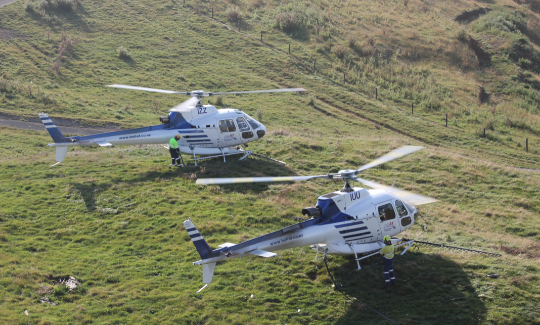Helicopter spraying is a common land management and agricultural practice across New Zealand, particularly in areas with challenging landscapes, remote access, or where broad coverage is needed quickly.
It combines aviation precision with modern application systems to manage weeds, pests, and even fertiliser distribution in locations that ground crews simply can’t get to.
From the rocky outcrops of Waikato’s King Country to the forestry blocks of the Central Plateau, to the agriculture and horticultural farms and lifestyle properties of the Bay of Plenty, this technique is an important part of maintaining our healthy, productive landscapes.
About helicopter spraying in the North Island
What helicopter spraying involves
At its core, helicopter spraying is just the aerial application of liquid products like herbicides, pesticides, fertilisers, and soil enhancers, using specialised equipment mounted to a helicopter.
Each heli is fitted with a tank, pump, and boom or nozzle system that allows pilots to dispense product evenly over a defined area.
The entire process is heavily dependent on the accuracy of Modern GPS technology. Heli pilots utilise digital mapping tools that mark out spray boundaries with surprising accuracy, factoring in overspray and reducing waste.
Many operators also use flow-control technologies that can adjust the application rate as the helicopter’s speed changes, creating consistent coverage even in variable wind or terrain conditions.
Because New Zealand’s beautiful natural landscapes shift rapidly, from flat paddocks to steep ridgelines – all within a few metres, the agility of a helicopter helps maintain coverage that is both uniform and targeted.
When helicopter spraying is applicable
New Zealand properties often have features that make ground spraying difficult, like our deep gullies, regenerating scrub, wetlands, riverbanks, and rough hill country.
Helicopter spraying helps landowners or the Department of Conservation treat these areas without disturbing vegetation or soil through vehicle use.
The method is most common in:
- Pastoral farming to manage gorse, broom, blackberry, and other persistent weeds.
- Forestry especially in establishing young trees, controlling competing vegetation, or applying fertiliser to improve early growth.
- Environmental restoration where operators target invasive species without damaging native plants.
- Poison application like 1080 to control pests
Weather conditions, however, play a major role. A good operator will only fly when conditions support safe and accurate application.
How operators manage safety and compliance
New Zealand has strong restrictions around spray use, which reputable helicopter companies follow closely. As part of the process, each spray job starts with a thorough site assessment including terrain, potential water runoff, nearby houses, sensitive ecosystems, or public areas that might be affected by overspray.
Communication with neighbours and landowners is a standard part of planning. Many companies provide a detailed map showing spray zones, entry points, and safety notes so everyone involved understands the process, and some are more than willing to help inform residents, councils and governing bodies and more.
Environmental responsibility is such a strong area of focus for helicopter spraying and spraying companies make an effort to adhere to and promote positive environmental practises.
Pilots should be experienced in chemical handling, drift reduction, and native ecosystem protection, all of which typically requires extensive additional training. Helicopter companies also maintain robust cleaning and rinsing procedures to avoid cross-contamination between jobs.
What to consider when deciding if helicopter spraying is right for you
Helicopter spraying tends to be best-placed for areas of land rendered inaccessible with ground equipment. If the area is too remote, too large or expansive, or if heavy machinery would cause erosion or damage, an aerial approach tends to be more practical, safe and effective. Scale matters too: large or irregularly shaped blocks are often more cost-effective to treat from the air.
Budget is another factor.
How much does helicopter spraying cost?
Helicopter time is a premium service, though the efficiency often offsets the cost. Prices vary, but it can cost upwards of $300 an hour to utilise helicopter spraying.
It’s also worth considering your long-term land goals. Some properties need a single targeted spray to get weeds under control, while others may require a multi-year vegetation programme. So talk with operators and agronomy consultants, and align helicopter spraying with broader land-management objectives.
What we think
Helicopter spraying offers landowners a fast, precise, and adaptable way to manage vegetation and improve their land productivity. Success requires the right planning and a skilled operator. Ultimately, if you’re dealing with large, steep or sensitive terrain, helicopter spraying can deliver results that ground equipment simply can’t match.
Any recommendations for heli spraying services?
Here are some of our top helicopter spraying service operators in the North Island, who have a range of experience in the sector and service.
Heli A1
Website: helia1.co.nz
Email: info@helia1.co.nz
Phone: +64 7 873 6695
Helicopter Services (BOP) Ltd
Website: helicopterservices.nz
Email: info@helicopterservices.nz
Phone: +64 7 378 8074
Helisika Helicopters Ltd
Website: helisikahelicopters.co.nz
Email: via website contact form
Phone: 0508 435 424 or 09 296 5337
Rotor Work Ltd
Website: rotorwork.co.nz
Email: via website contact form
Phone: 0800 276 867
Tararua Heliwork Ltd
Website: tararuaheliwork.co.nz
Email: contact@tararuaheliwork.co.nz
Phone: 06 376 8000 or 0274 320 607
